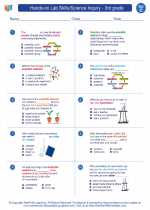The Limbic System
The limbic system is a complex set of structures in the brain that is involved in emotions, motivation, learning, and memory. It is sometimes referred to as the "emotional brain" and plays a crucial role in regulating many of the body's physiological and emotional responses.
Structures of the Limbic System
- Hippocampus: This structure is primarily associated with memory formation and spatial navigation.
- Amygdala: The amygdala is involved in the processing of emotions, particularly fear and pleasure responses.
- Hypothalamus: This structure plays a key role in regulating hunger, thirst, body temperature, and the release of hormones.
- Thalamus: The thalamus acts as a relay station for sensory information and is involved in consciousness and alertness.
- Cingulate gyrus: This structure is involved in emotional and cognitive processing, as well as regulating autonomic functions.
Functions of the Limbic System
The limbic system is involved in a wide range of functions, including:
- Emotional regulation
- Motivation and reward processing
- Memory formation and retrieval
- Learning and decision-making
- Regulation of physiological responses such as heart rate, blood pressure, and stress hormones
Study Guide
- What are the primary structures of the limbic system?
- Describe the functions of the hippocampus, amygdala, hypothalamus, and thalamus within the limbic system.
- Explain the role of the limbic system in emotional regulation and memory formation.
- How does the limbic system contribute to the processing of emotions and motivation?
- Discuss the interconnected nature of the limbic system with other brain regions and its impact on overall brain function.
Studying the limbic system can provide a deeper understanding of the brain's role in emotions, memory, and decision-making, and its influence on overall behavior and well-being.
.◂Science Worksheets and Study Guides Third Grade. Hands-on Lab Skills/Science Inquiry - 3rd grade
Study Guide Hands-on Lab Skills/Science Inquiry - 3rd grade
Hands-on Lab Skills/Science Inquiry - 3rd grade  Worksheet/Answer key
Worksheet/Answer key Hands-on Lab Skills/Science Inquiry - 3rd grade
Hands-on Lab Skills/Science Inquiry - 3rd grade  Worksheet/Answer key
Worksheet/Answer key Hands-on Lab Skills/Science Inquiry - 3rd grade
Hands-on Lab Skills/Science Inquiry - 3rd grade  Worksheet/Answer key
Worksheet/Answer key Hands-on Lab Skills/Science Inquiry - 3rd grade
Hands-on Lab Skills/Science Inquiry - 3rd grade  Worksheet/Answer key
Worksheet/Answer key O-W-L
O-W-L  Vocabulary/Answer key
Vocabulary/Answer key Hands-on Lab Skills/Science Inquiry - 3rd grade
Hands-on Lab Skills/Science Inquiry - 3rd grade  Vocabulary/Answer key
Vocabulary/Answer key Hands-on Lab Skills/Science Inquiry - 3rd grade
Hands-on Lab Skills/Science Inquiry - 3rd grade 

 Worksheet/Answer key
Worksheet/Answer key
 Worksheet/Answer key
Worksheet/Answer key
 Worksheet/Answer key
Worksheet/Answer key
 Worksheet/Answer key
Worksheet/Answer key
 Vocabulary/Answer key
Vocabulary/Answer key
 Vocabulary/Answer key
Vocabulary/Answer key

The resources above cover the following skills:
Science as Inquiry and Process: A student should understand and be able to apply the processes and applications of scientific inquiry. A student who meets the content standard should:
Develop an understanding of the processes of science used to investigate problems, design and conduct repeatable scientific investigations, and defend scientific arguments.